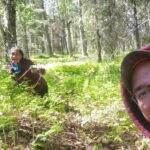Joel Isaak and Helen Dick
Birch Bark Canoe Building
To encourage the maintenance and revitalization of customary Alaska Native artistic expressions and technologies, the Litnaurluni program provided funding support for in-depth arts projects that transmit Alaska Native arts practices across generations.

During a year-long project, Joel Isaak worked with Helen Dick to build a birch bark canoe as part of a Litnaurluni grant sponsored by the Alaska Native Heritage Center.
Building this canoe was a journey. The canoe tree knew this is what we needed at this time. It was a journey of healing, connection, and remembrance. There is a spiritual connection when working with trees and lands that are old like this. This birch tree started growing before the last canoe was made by our people in this area. It started growing when Dena’ina language was still spoken in our area as the first language. It serves as a bridge from our past to the future and is helping us as young language and culture bearers on our journey of healing and reclamation.
Perhaps the greatest impact this project had on our community is that it has reenergized our people to learn more about material culture and language. Other organizations and communities have asked to have us teach their youth how to do this. Museums have reached out asking us to come research their collection. There has been excitement on Elders’ faces as they hear about and see what we are doing. It is sparking new stories and jogging old memories. Participants and observers shared that what we are doing is inspiring them to want to learn how to start canoe building and also other cultural practices. My advice is to just start doing it. Your first one does not have to be perfect. You will progressively improve as you continue your cultural practices.
Large-scale projects like this teach us so much. They require us to connect with the land and each other. We have to trust that the land will provide what is needed. It stretches us to make sure we are in a good mindset. It makes us grounded as people. It is extremely empowering to work on a project like this. It serves as a statement that we are still here as Native people and shines light on why our cultural lifeways are so endangered. We are making this work for our community to use and learn from. It is for our people to use and live within our homes the way we always have.








